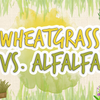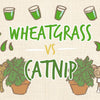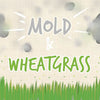Wheatgrass Vs Apple Cider Vinegar: The Complete Guide
It seems wheatgrass, and apple cider vinegar went from being a reserve for the health food stores to mainstream dietary trends overnight. And gladly so, these superfoods are packed with essential nutrients and antioxidants. The following guide seeks to demystify wheatgrass and apple cider vinegar, their health benefits, and even how to prepare them at home.
Not Much Time? Skip To What You'd Like To Learn...
-
What Is Wheatgrass?
-
What Is Apple Cider Vinegar?
-
Differences Between Wheatgrass And Apple Cider Vinegar
-
Common Reasons People Drink Apple Cider Vinegar or Consume Wheatgrass
-
Which Is Healthier?
-
Wheatgrass, Apple Cider Vinegar, And Celiac Disease
-
Growing and Making Differences
-
How To Consume
-
Where To Buy From
-
History of Apple Cider Vinegar And Wheatgrass
-
Risks Associated With Consuming Apple Cider Vinegar And Wheatgrass
-
Juice Powders
-
Common Questions
What Is Wheatgrass?
Wheatgrass is the freshly sprouted seeds of Triticum aestivu (common wheat plant). Wheatgrass is popular for its concentrated nutrients, which helps the body to perform properly. The health benefits provided by wheatgrass are numerous, including alleviating inflammation.
What Is Apple Cider Vinegar?
Apple cider vinegar is vinegar made via fermenting apple juice. The strong smell and sour taste of the vinegar are achieved after fermentation. It is used for baking, salad dressing, cooking, and also as a preservative.
Differences Between Wheatgrass And Apple Cider Vinegar

1. How Long To Grow
Wheatgrass takes less time to grow compared to the apple cider vinegar fermentation process, below is the full explanation:
-
Wheatgrass takes 2 days to germinate in trays and pots and 6-10 days to be ready for harvesting. Insufficient sunlight and water may inhibit growth or the development of its normal rich, green color.
-
It takes 3 to 6 weeks to brew apple cider vinegar, and it is important to stir your cider every 3-4 days to let the cider ferment evenly.
2. Consumption Differences
Apple cider vinegar can be incorporated into more dishes compared to wheatgrass, below is the full explanation:
-
Wheatgrass can be consumed as wheatgrass juice or as wheatgrass shots. Wheatgrass can also be consumed in the form of wheatgrass powder made through dehydration.
-
Apple cider vinegar can be consumed by drinking 15-30ml every day to help boost your immunity. It can also be used in marinated meat, dressed salads, vegan buttermilk, braised liquid, poached eggs, and bone broth, among other foodstuffs.
3. Smell
Apple cider vinegar has a more noticeable smell with floral notes while wheatgrass is not as distinctive, below is the full explanation:
-
Wheatgrass has a fresh ‘green’ scent, just like newly-mown grass. This smell may irritate other individuals who are not used to wheatgrass.
-
Apple cider vinegar has a pungent smell with a floral apple scent. However, the pungent is not strong, like the smell of malt vinegar.
4. Where They Grow
Wheatgrass can be grown both outdoors and indoors while ACV can only be fermented indoors, below is the full explanation:
-
Wheatgrass can be grown indoors or outdoors in any part of the world with temperatures of 60-75 Fahrenheit. You can also brew apple cider vinegar at home by reading and following the guidelines provided in this guide.
5. Taste
Wheatgrass and ACV have strong tastes although apple cider vinegar is more acidic, below is the full explanation:
-
Raw wheatgrass has a strong taste which leaves and earthly aftertaste in your mouth. Apple cider vinegar has a sour taste caused by the breakdown of alcohol into acetic acid by the bacteria culture.
Common Reasons People Drink Apple Cider Vinegar or Consume Wheatgrass
1. Apple Cider Vinegar
-
To Manage Diabetes and Lower Blood Sugar Levels.
Taking 2 tablespoons of ACV before bedtime helps to reduce blood sugar the following morning by 4 percent. It can also lower the levels of blood sugar by improving insulin function after meals.
Link: ncbi.gov
-
To Lose Weight.
Adding vinegar to a high carb meal leads to an increased feeling of fullness. This, in turn, leads to the consumption of fewer calories hence weight loss.
Link: tandfonline.com
-
To Boost Skin Health.
Apple cider vinegar is known as a common remedy for different skin conditions such as eczema and dry skin. Using topical apple cider vinegar helps to rebalance the skin’s pH. This helps to improve the protective skin barrier. However, using cleansers and alkaline soaps could make symptoms worse by irritating eczema.
Link: tandfonline.com
2. Wheatgrass
-
To Alleviate Inflammation.
Wheatgrass is rich in chlorophyll, which has powerful anti-inflammatory properties. Chlorophyll compounds such asper chlorophyll a and pheophytin are particularly associated with anti-inflammatory activities in the body.
Link: pubmed.gov
-
To Promote Weight Loss.
Wheatgrass, just like other green plants, contains tiny compartments called thylakoids, which enhances satiety and promotes weight loss.
Link: ncbi.gov
-
To Kill Cancer Cells.
Numerous test-tube studies have established that the high antioxidant content of wheatgrass can kill cancer cells. Combining the traditional treatment of cancer with wheatgrass juice can also minimize the adverse effects of cancer.
Link: ncbi.gov
Which Is Healthier?
Nutrients In Apple Cider Vinegar (per 100 grams serving size)
-
Calories: 22
-
Sodium: 5 mg
-
Potassium: 73 mg, representing 2 percent of Daily Value (DV)
-
Carbohydrates: 0.9g
-
Iron: 1%
-
Magnesium: 1%
Nutrients In Wheatgrass (per 100g serving size)
-
Calories: 175
-
Fat: 4.98 g, representing 6% of Daily Value
-
Sodium: 65mg, or 3% of DV
-
Carbohydrates: 5.8g, or 2% of DV
-
Protein: 28.36g
-
Calcium: 25g, or 2% of DV
-
Iron: 0.6mg, or 3% of DV
-
Potassium: 58mg, or 1% of DV
-
Vitamin C: 11.3mg, or 13% of DV
Conclusion
Wheatgrass turns out to be more nutritious than apple cider vinegar based on their nutritional breakdown. This is because wheatgrass is high in numerous essential nutrients such as calories, sodium, and carbohydrates compared to apple cider vinegar. Wheatgrass is also rich in additional nutrients such as fat, protein, calcium, and vitamin C. However, apple cider vinegar is high in potassium, iron, and also contains magnesium as compared to wheatgrass.
Wheatgrass, Apple Cider Vinegar, And Celiac Disease

Celiac disease is usually caused by gluten found in cereals. Gluten triggers an immune response in the small intestines when celiac disease patients consume gluten in wheat or other cereals such as rye and barley.
[Disclaimer: Always check the labels on ACV and wheatgrass products to ensure that they do not contain any compounds that might trigger adverse reactions in your body.]
What Is Celiac Disease?
Celiac disease is an immune reaction that occurs after eating gluten. Over time, this immune reaction creates inflammation, which causes damages in the lining of the small intestines hence medical complications. The typical symptom of celiac disease is diarrhea, with additional symptoms such as fatigue, bloating, anemia (low blood count), and osteoporosis.
Can You Eat Wheat Or Drink Apple Cider Vinegar When Suffering From Celiac Disease?
You should be cautious with wheatgrass if you have celiac disease. It is necessary to ask questions concerning the wheatgrass you want to buy and ensure that the wheatgrass product that you buy is gluten-free.
However, drinking pure distilled apple cider vinegar is important because it is gluten-free and also helps to alleviate several stomach dilemmas such as gluten ingestion. Seasoned and flavored apple cider vinegar are discouraged for people who have celiac disease because they may have traces of gluten.
Reference: link
Growing and Making Differences
Wheatgrass is usually grown through sprouting, while apple cider vinegar is made through fermentation.
How to Grow Wheatgrass
The stages involved in the growing process of wheatgrass include;
-
Soaking and sprouting
-
Setting up an indoor garden
-
Planting your wheatgrass sprouts for indoor growing
-
Maintaining your sprouted wheatgrass for indoor gardening
-
Harvesting your wheatgrass.
How to Make Apple Cider Vinegar
Making organic raw apple cider vinegar involve;
-
Washing and chopping apples into medium-sized pieces.
-
Mixing sugar and water to pour on the chopped apples.
-
Covering your jar using cheesecloth, a paper towel, or secure using a band.
-
Keep the jar in your pantry and ensure it is warm and dark.
-
Strain the liquid and remove the pieces of apple.
-
Place the strained liquid in the same jar and use the same cheesecloth or paper towel to cover it.
-
Return the jar to your pantry and leave it for 4-6 weeks. Keep stirring with a wooden spoon or a plastic once a day. Your vinegar will be ready for tasting in 4 weeks but will be lovely in 6 weeks.
Conclusion
It is easier to grow wheatgrass because your wheatgrass will germinate in 2 days and ready for harvesting in 6-10 days. Making apple cider vinegar takes 4-6 weeks in addition to 6-10 years taken by apple trees to bear apples. Making apple cider vinegar is, however, cheap because you only need to buy a few apples as opposed to growing wheatgrass, which involves buying wheatgrass seeds and growing kits.
How To Consume
Wheatgrass
-
Juice
Wheatgrass juice can be prepared by putting your wheatgrass in a high-powered blender, adding water to help liquefy the grass, and blending.
This recipe is inspired by: alphafoodie.com
-
Smoothies
Place coconut water or water, milk substitute, fresh wheatgrass tangerines or oranges, frozen banana, and ice in a blender and blend until smooth.
This recipe is inspired by: indianhealthyrecipes.com
-
Shots
You can make your wheatgrass shots using a slow juicer, mortar and hand pestle, or a high- powered blender. Drink 60-120ml immediately after juicing.
This recipe was inspired by: blenderbabes.com
Apple Cider Vinegar
-
Shots
A typical dose of apple cider vinegar should be 15-30 ml or 1-2 teaspoons. Apple cider vinegar has a sour taste caused by bacteria and the wheatgrass ‘mother.’
Recipes
1. Apple Cider Vinegar And Honey Shots
This recipe has been inspired by: 40approns.com
Ingredients:
-
Dash ground cinnamon
-
1 tablespoon of honey (most preferably local and raw
-
1 tablespoon of raw apple cider vinegar
-
1 tablespoon of warm water (you can add more if necessary)
Instructions
1. Whisk the warm water in the honey to combine. Stir in cinnamon and ACV
2. Add cinnamon and apple cider vinegar
3. Take your shot
2. Apple Cider Vinegar Shot With Apple Pie Flavor
This recipe has been prepared by: thymeandjoy.com
Ingredients
-
10-15 drops of vanilla-flavored stevia or Stevia
-
4 tablespoons of raw apple cider vinegar
-
¼ teaspoon of ground cinnamon
-
6 oz of organic apple juice
-
1 drop of vanilla extract
Instructions
1. Mix all the ingredients in a 16 oz mason jar
2. Secure the lid and shake to combine all the ingredients fully
3. Drink one shot of 1.52 ounce daily
4. You can store in your fridge for one month using an airtight container.
3. Apple Cider Vinegar Shots
This recipe has been made by yummymummykitchen.com
Ingredients
-
1 tablespoon of Bragg’s apple cider vinegar
-
8 oz. sparkling or still water
-
1 cup of unsweetened fresh orange or pineapple juice
-
1/8 to ¼ teaspoon of ginger (freshly grated)
Instructions
-
Mix apple cider vinegar, orange or pineapple juice, and ginger in a small jar
-
Whisk or shake to mix.
-
Cover and refrigerate for 2-3 days to be ready for use.
-
When ready, combine with 8 oz. of still or sparkling water then drink.
4. Apple Cider Vinegar Cocktail
This recipe has been inspired by valyastasteofhome.com
Ingredients
-
Apple cider vinegar
-
Water
-
Organic raw honey
Instructions
-
In a glass cup, combine apple cider vinegar, warm water, and honey.
-
Stir together and allow the cocktail to sit in the glass for a few minutes to dissolve the honey.
-
Stir well and enjoy your shot.
Where To Buy From
-
Wheatgrass
It is recommended to buy your frozen wheatgrass and wheatgrass powder from Amazon. You can also purchase your wheatgrass from any trusted grocery store near you.
-
Apple Cider Vinegar
you can also buy your apple cider vinegar from Amazon to increase your chances of obtaining your preferred taste. You can also check with your local supermarket if they have apple cider vinegar.
History of Apple Cider Vinegar And Wheatgrass
-
Wheatgrass
The history of wheatgrass traces back to more than 5000 years to ancient Egypt and maybe even the early civilizations of Mesopotamia. Reports indicate that ancient Egyptians considered the young leafy wheatgrass blades sacred and prized them because of its positive impacts on their vitality and health.
-
Apple Cider Vinegar
Evidence of apple trees can be dated back to 1300 B.C. The trees grew along the banks of River Nile, and since Egyptians enjoyed beer, it is believed they used it to brew beer.
Risks Associated With Consuming Apple Cider Vinegar And Wheatgrass
What Is High-Risk Food?
High-risk foods refer to any type of ready-to-eat food that promotes the growth of pathogenic bacteria and requires no further cooking or treatment.
Is Apple Cider Vinegar Or Wheatgrass High-Risk Food?
Apple cider vinegar is a high-risk food compared to wheatgrass. This is because the consumption of large amounts of apple cider vinegar is associated with numerous risks that may cause serious health problems to some individuals.
What Are The Risks Of Apple Cider Vinegar And Wheatgrass?
-
Apple Cider Vinegar
Consuming inappropriate amounts of apple cider vinegar may cause risks such as delayed stomach emptying, digestive side effects, bone loss, and low potassium levels, throat burns, and tooth enamel erosion. Other effects of too much apple cider vinegar are skin buns and drug interactions in diabetes medication and digoxin (Lanoxin).
-
Wheatgrass
The risks associated with consuming wheatgrass include constipation, nausea, headache, influenza, and loss of appetite. However, wheatgrass is generally considered to be healthy food because of the numerous health benefits associated with it.
Juice Powders

Juice powders refer to a powder-designed processed food product designed to mix with water to acquire a beverage that resembles soda or fruit juice flavor.
Wheatgrass Juice Powders
Some of the most popular wheatgrass juice powders include wheatgrass latte and wheatgrass smoothie. You can also make wheatgrass juice powder by adding powdered wheatgrass in a glass of warm water, tea, or porridge.
Can You Drink Both Wheatgrass and Apple Cider Vinegar on The Same Day?
It is advisable to drink 1-2 teaspoon of wheatgrass and vinegar once a day before taking a heavy meal. This will help to improve your digestion and reduce constipation.
Common Questions
Which Is Better Wheatgrass Or Apple Cider Vinegar?
Wheatgrass is better compared to apple cider vinegar because it is considered to be relatively safe for consumption. ACV is an acidic food hence can, therefore, erode your tooth enamel.
What Are The Side Effects Of Apple Cider Vinegar?
The side effects of apple cider vinegar include low potassium levels, tooth enamel erosion, throat burns, and digestive side effects.
Is Apple Cider Vinegar Good For Inflammation?
Using apple cider vinegar is a good way to reduce inflammation. The anti-inflammatory properties of apple cider vinegar can assist with arthritis symptoms such as swelling and pain.
What Is Apple Cider Vinegar Good For?
Apple cider vinegar is good for reducing cholesterol, aiding weight loss, improving diabetes symptoms, and lowering blood sugar levels.
Can Apple Cider Vinegar Cure Cancer?
It is still hard to prove that using ACV to create an alkaline environment in your body can prevent or cure cancer.
What Are The Benefits Of Apple Cider Vinegar?
The benefits of consuming apple cider vinegar include improving insulin sensitivity, reducing belly fat, lowering blood sugar levels, lowering blood pressure and improving heart health, lowering cholesterol, and improving digestion.
Is Apple Cider Vinegar Good For Liver?
Apple cider vinegar is good for the liver because it has detoxification properties that help to cleanse the liver effectively.
Does Chlorella Alkalize the Body?
Chlorella is an alkaline food with an abundance of metals such as magnesium and potassium and is treasured for maintaining blood weak alkaline.







